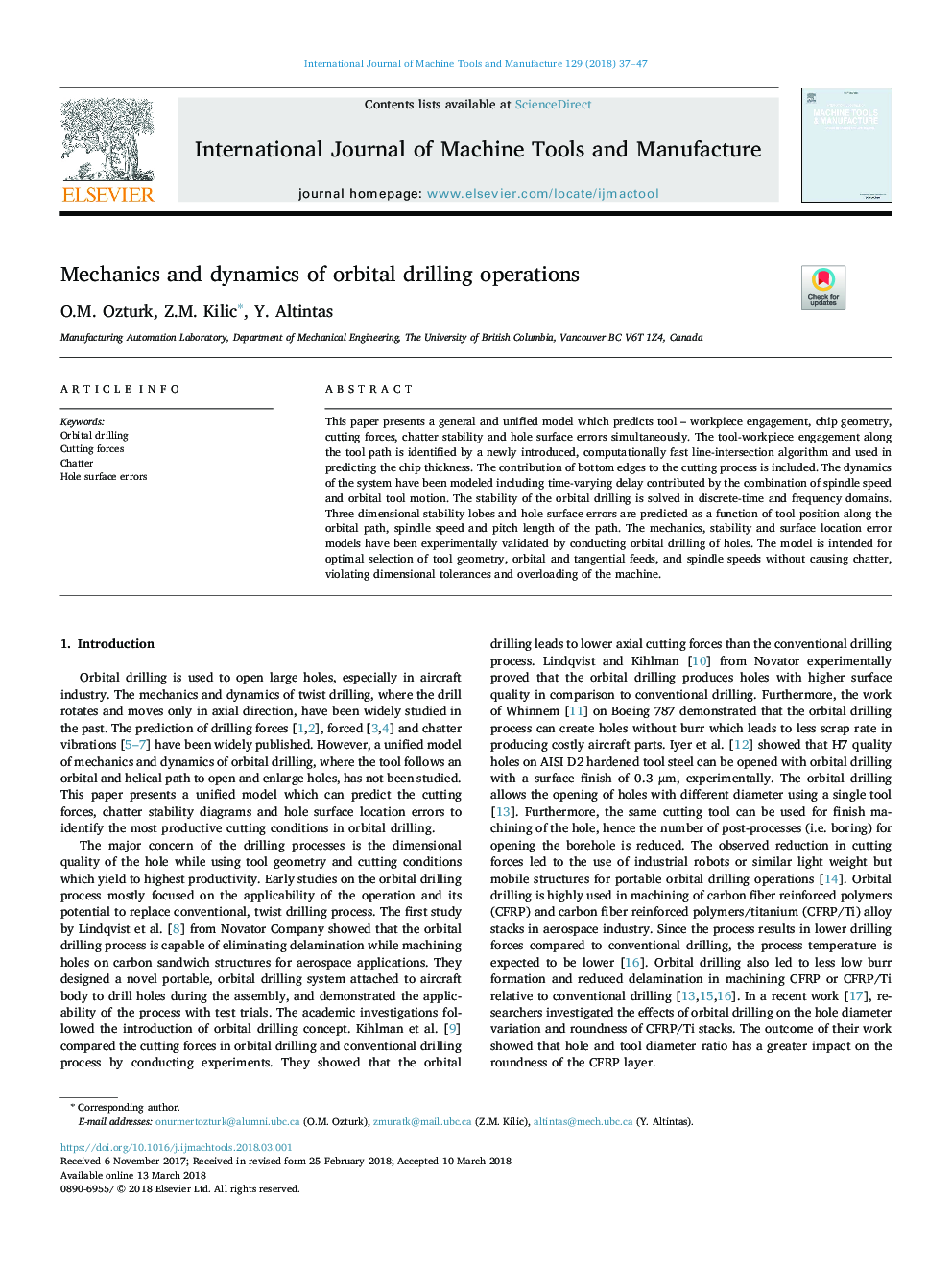| کد مقاله | کد نشریه | سال انتشار | مقاله انگلیسی | نسخه تمام متن |
|---|---|---|---|---|
| 7173351 | 1464465 | 2018 | 11 صفحه PDF | دانلود رایگان |
عنوان انگلیسی مقاله ISI
Mechanics and dynamics of orbital drilling operations
ترجمه فارسی عنوان
مکانیک و پویایی عملیات حفاری مداری
دانلود مقاله + سفارش ترجمه
دانلود مقاله ISI انگلیسی
رایگان برای ایرانیان
کلمات کلیدی
حفاری یاطاقان، نیروهای برشی، بلاگر اشتباهات سطح سوراخ،
ترجمه چکیده
این مقاله یک مدل کلی و یکپارچه را ارائه می دهد که به طور همزمان ابزارها - تعامل قطعات قطعه، هندسه تراشه، نیروهای برش، پایداری تراشه و خطاهای سطح سوراخ را پیش بینی می کند. تعامل چرخش ابزار در طول مسیر ابزار توسط یک الگوریتم تقاطع خطی جدید معرفی شده، محاسباتی سریع شناسایی شده و در پیش بینی ضریب تراشه مورد استفاده قرار می گیرد. سهم لبه های پایین در فرایند برش گنجانده شده است. پویایی سیستم مدل شده است از جمله تاخیر زمانی متغیر توسط ترکیبی از سرعت چرخش و حرکت ابزار مدار. پایداری حفاری مداری در حوزه های زمانی گسسته و فرکانس حل شده است. لبه ثبات سه بعدی و خطاهای سطحی سوراخ به عنوان تابع موقعیت ابزار در امتداد مسیر مدار، سرعت چرخش و طول مسیر مسیر پیش بینی شده است. مدل های خطای مکانیک، پایداری و مکان یابی، با انجام حفاری های مدور حفره ها، به طور تجربی تایید شده اند. این مدل برای انتخاب مطلوب هندسه ابزار، مدارهای مداری و مماس، و سرعت چرخش بدون ایجاد پچ پچ، نقض تحرکات ابعادی و بارگذاری دستگاه طراحی شده است.
موضوعات مرتبط
مهندسی و علوم پایه
سایر رشته های مهندسی
مهندسی صنعتی و تولید
چکیده انگلیسی
This paper presents a general and unified model which predicts tool - workpiece engagement, chip geometry, cutting forces, chatter stability and hole surface errors simultaneously. The tool-workpiece engagement along the tool path is identified by a newly introduced, computationally fast line-intersection algorithm and used in predicting the chip thickness. The contribution of bottom edges to the cutting process is included. The dynamics of the system have been modeled including time-varying delay contributed by the combination of spindle speed and orbital tool motion. The stability of the orbital drilling is solved in discrete-time and frequency domains. Three dimensional stability lobes and hole surface errors are predicted as a function of tool position along the orbital path, spindle speed and pitch length of the path. The mechanics, stability and surface location error models have been experimentally validated by conducting orbital drilling of holes. The model is intended for optimal selection of tool geometry, orbital and tangential feeds, and spindle speeds without causing chatter, violating dimensional tolerances and overloading of the machine.
ناشر
Database: Elsevier - ScienceDirect (ساینس دایرکت)
Journal: International Journal of Machine Tools and Manufacture - Volume 129, June 2018, Pages 37-47
Journal: International Journal of Machine Tools and Manufacture - Volume 129, June 2018, Pages 37-47
نویسندگان
O.M. Ozturk, Z.M. Kilic, Y. Altintas,
